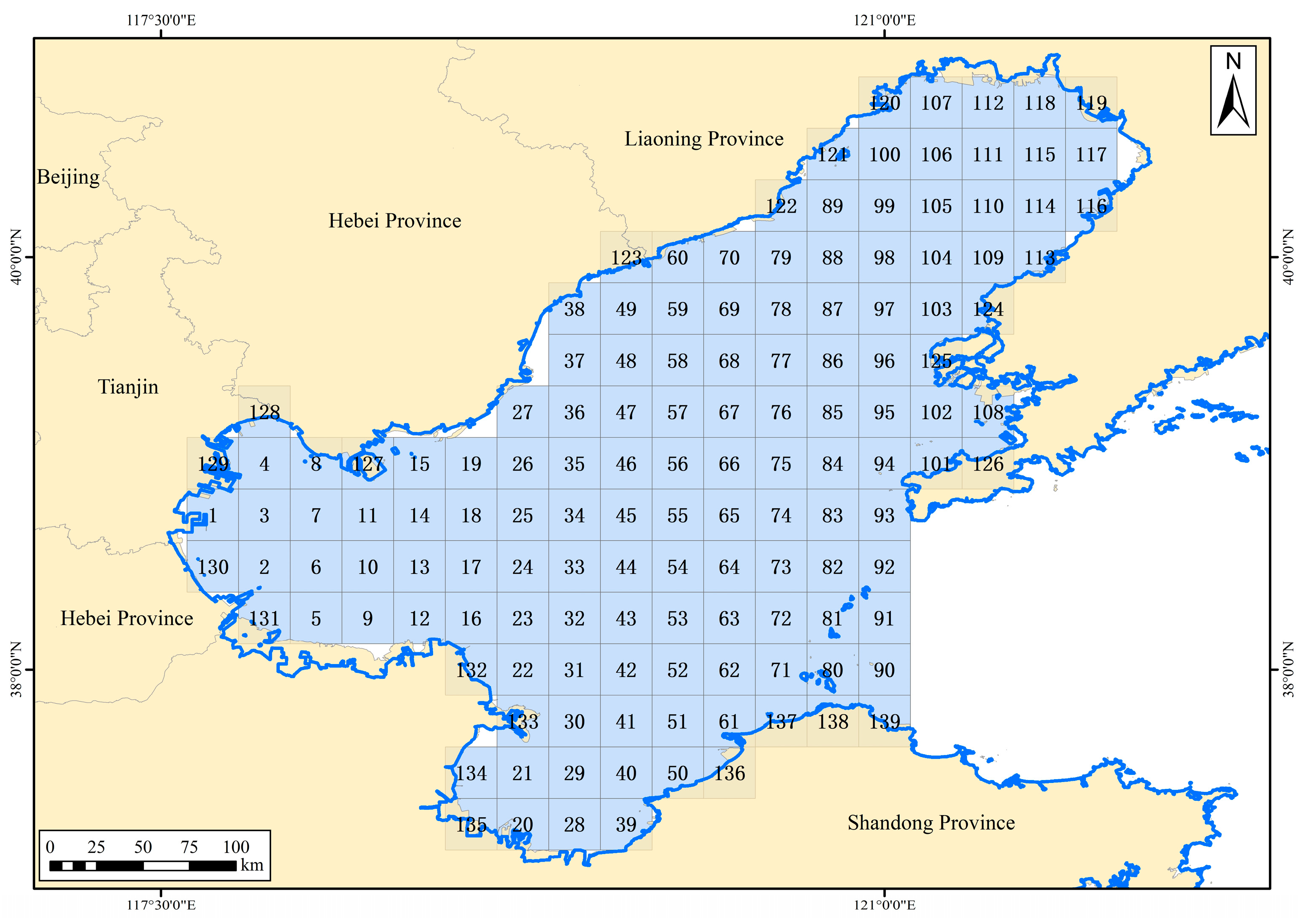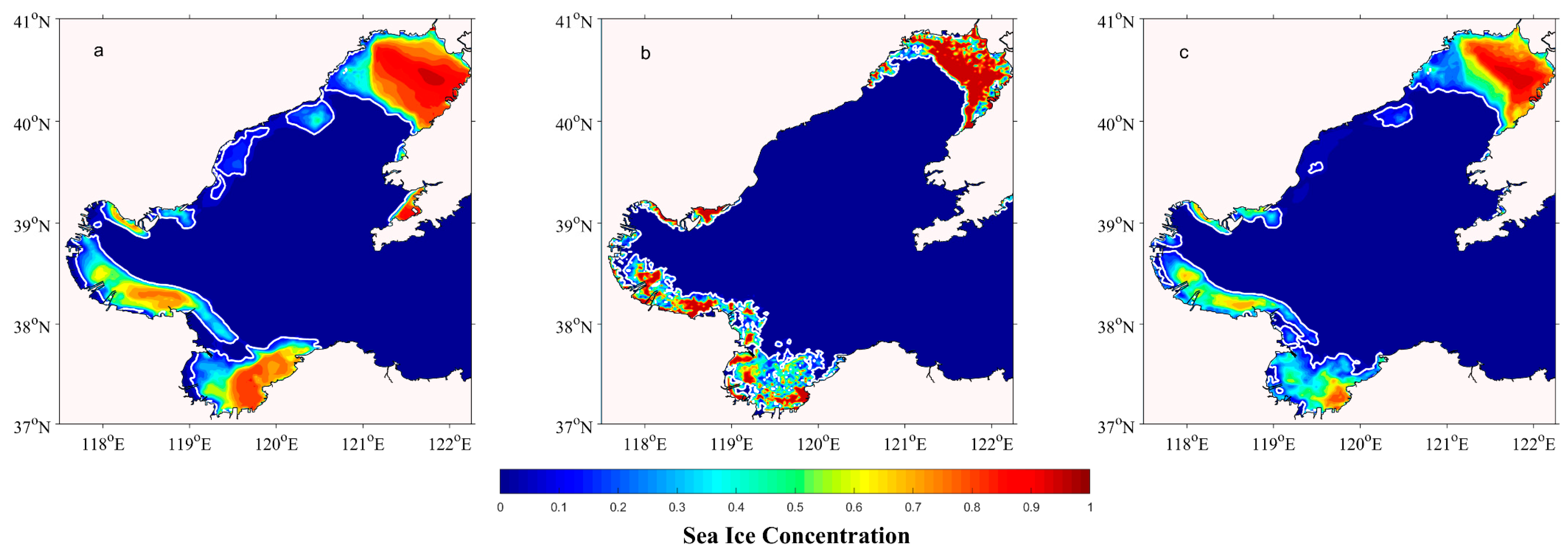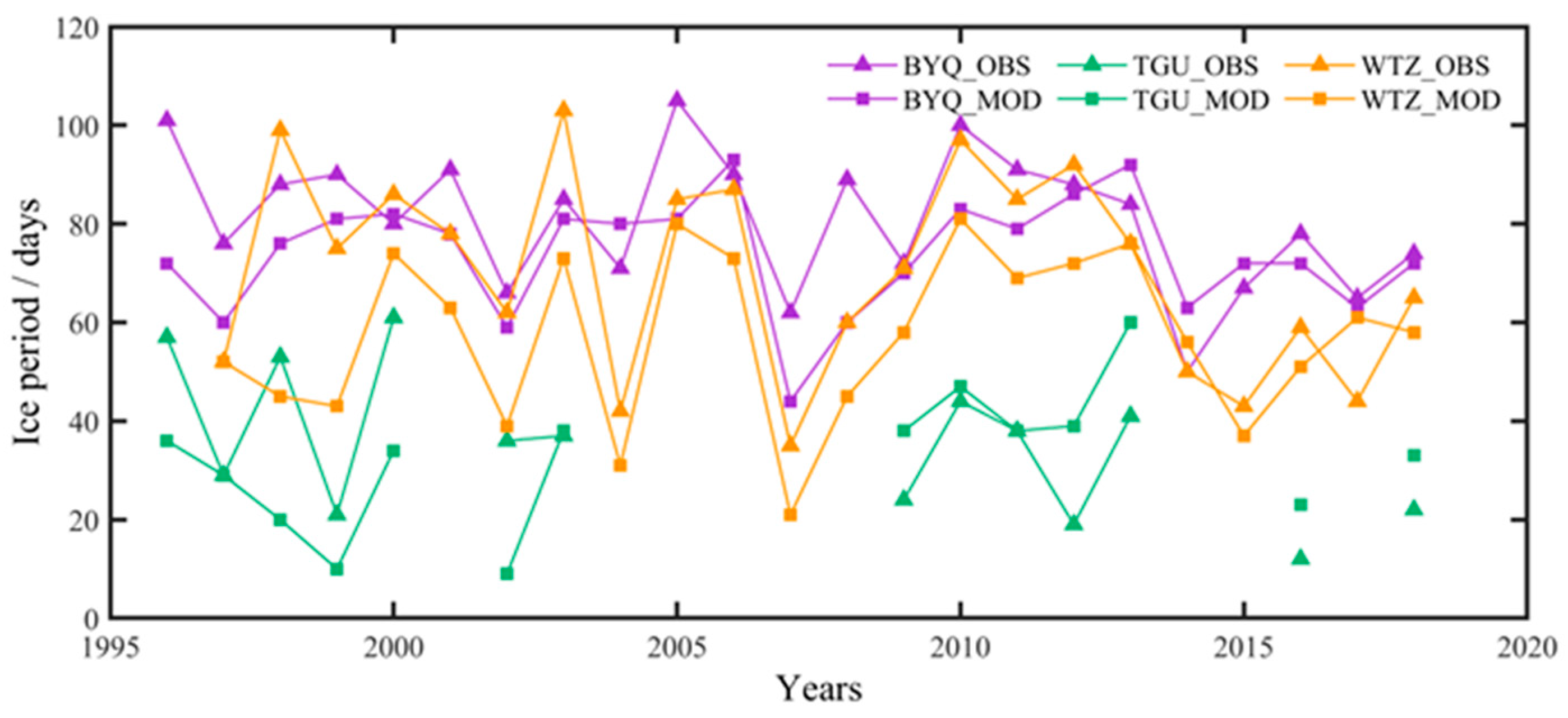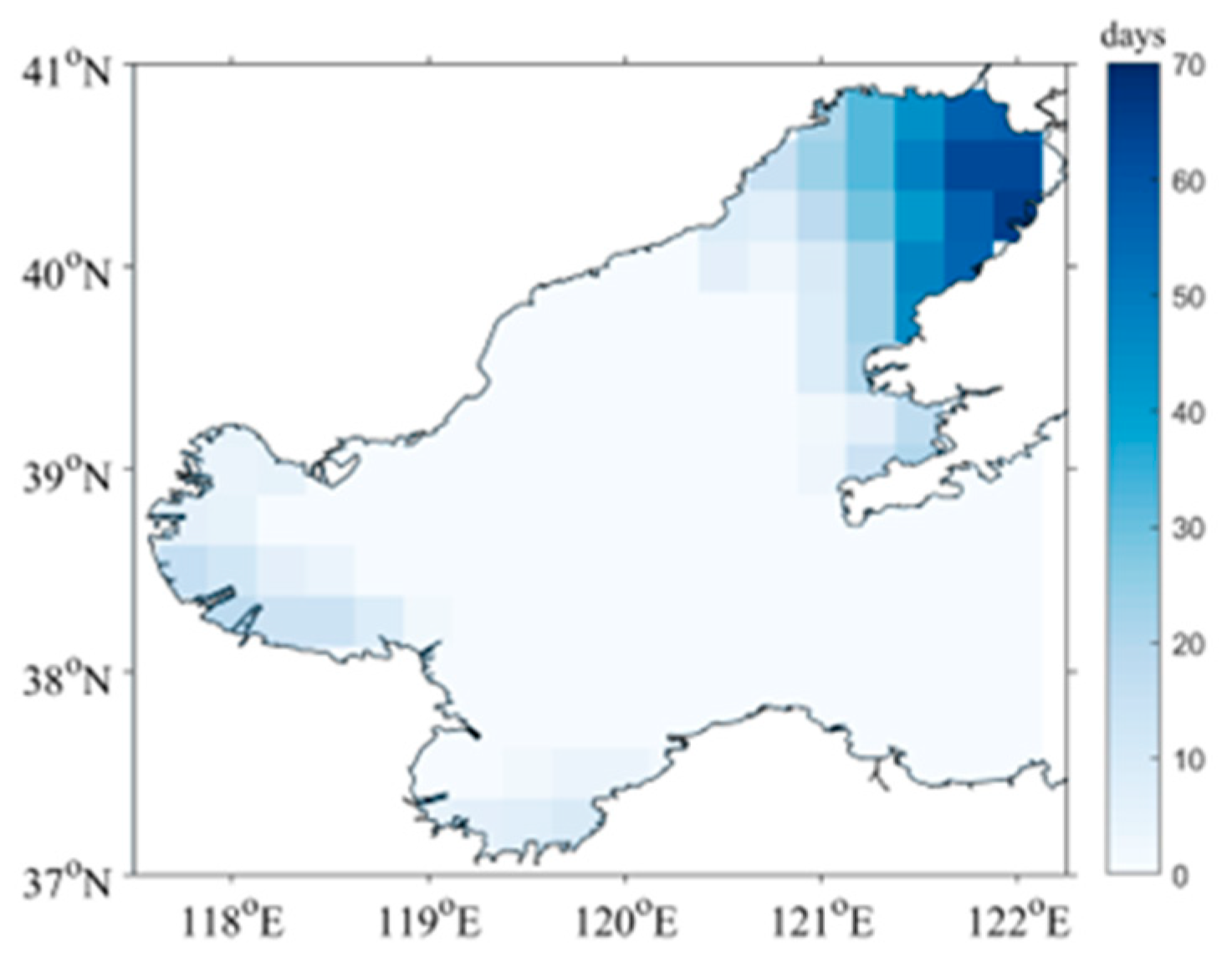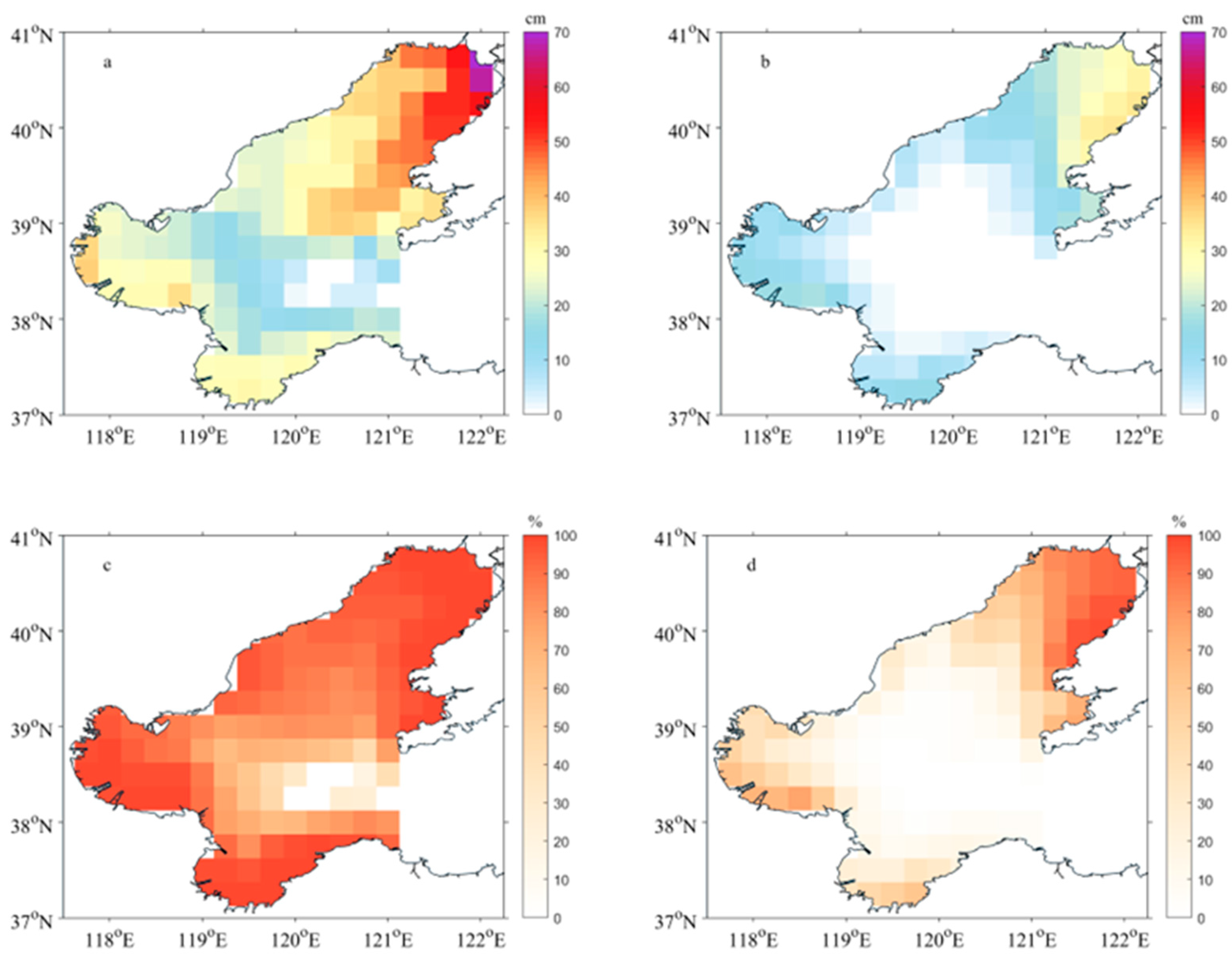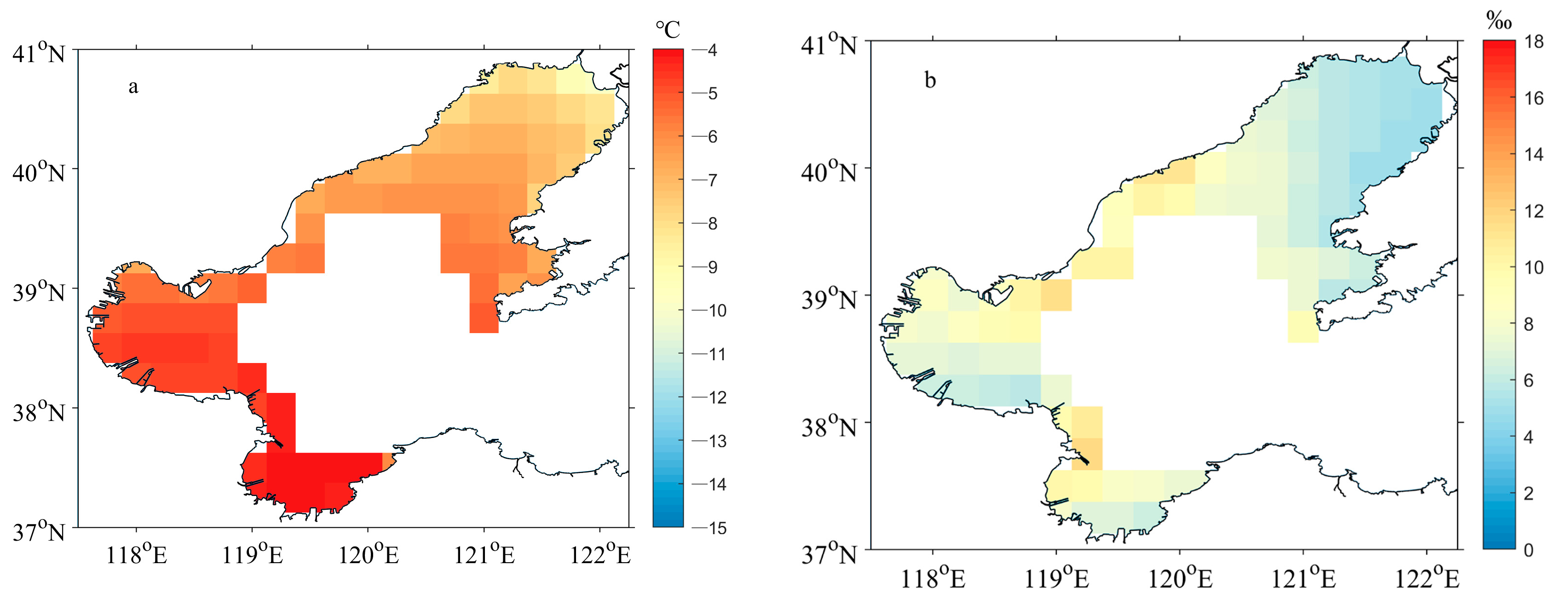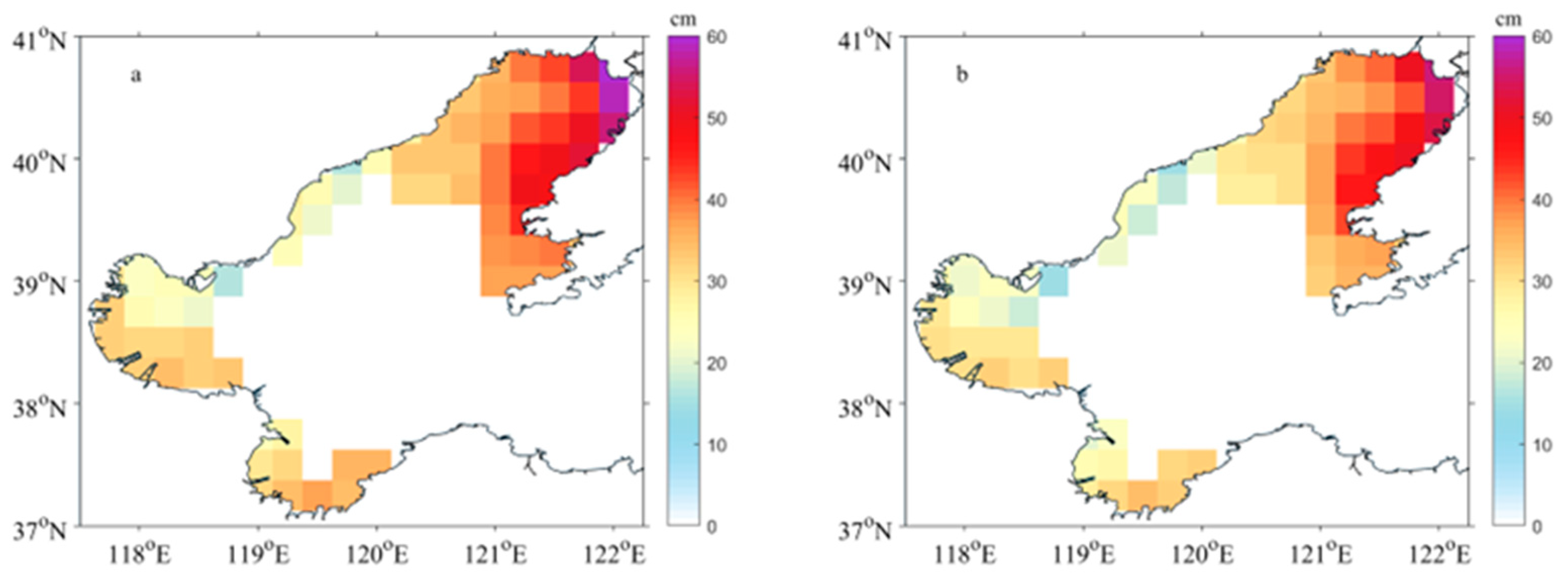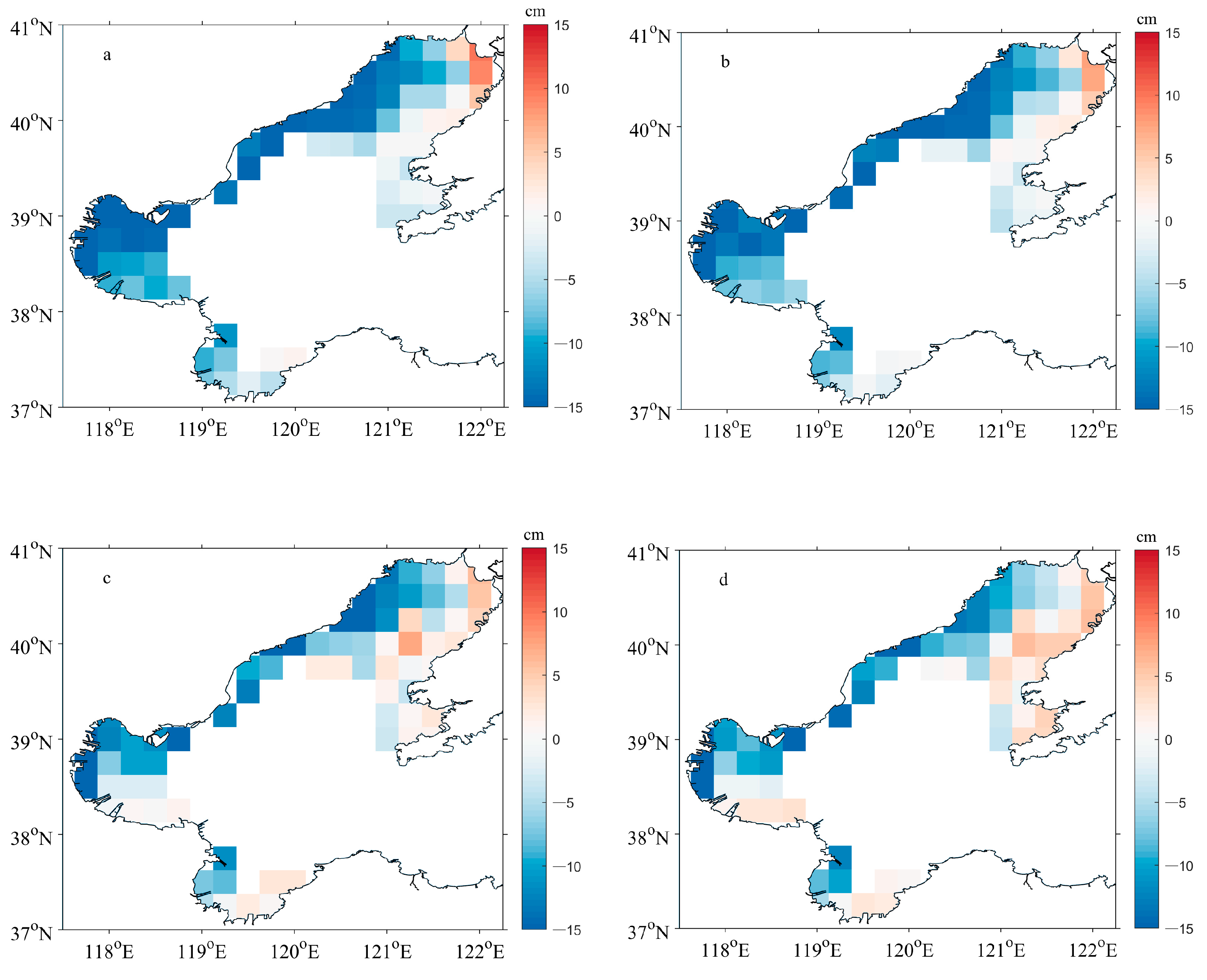1. Introduction
The Bohai Sea, the inland sea in the northern China, has a cold winter climate and is the southern boundary of the frozen waters in the Northern Hemisphere [
1]. In winter, sea ice in the Bohai Sea poses severe threats to port transportation, offshore oil and gas exploration, marine fisheries, etc. [
2]. To ensure the security of human activities in the Bohai Sea during winter, it is necessary to know the characteristics of sea ice in the Bohai Sea in winter [
3].
In order to facilitate distinguishing the differences in the ice characteristics in a large-scale sea area, the target sea area needs to be zoned according to various ice conditions [
4]. Unlike the ice in the Arctic Ocean, all the ice in the Bohai Sea is first-year ice. Under the influence of local thermal and dynamic factors, the sea ice in the Bohai Sea is mainly drift ice, with significant interannual variations [
5]. The engineering sea ice zone division in the Bohai Sea is primarily based on a series of sea ice parameters, such as ice concentration, ice thickness, ice type, ice period, etc. In 1984, the ARCTIC Corporation of the USA first divided the Bohai Sea into three ice zones: the Bohai Bay Ice Zone, the Bozhong Ice Zone, and the Laizhou Bay Ice Zone [
6]. A few years later, Liu et al. divided Liaodong Bay into the northern and southern ice zones, considering the different sea ice properties and climatic conditions [
7]. Afterward, Shen conducted an ocean survey to investigate China’s sea ice intensity division in 1992 [
6]. He divided the Bohai Sea into nine ice zones, considering the prospects for offshore oil and gas development. Entering the 21st century, Wu et al. divided the nearshore areas of the Bohai Sea and the northern Yellow Sea into 21 ice zones based on the fundamental characteristics of the distribution and changes of the sea ice in China, considering the convenience of engineering design and production departments [
8]. The 21-ice-zone scheme is currently the most commonly used standard [
4,
9].
The engineering ice-resistance designs are based on the sea ice characteristic parameters [
10]. In recent years, the overall ice condition in the Bohai Sea has been milder, but extreme meteorological events, especially the strong cold waves, have gradually increased in winter [
2]. Along the Bohai coast, the seasonal resources of wind energy [
11], solar thermal energy [
12], and wave energy [
13] are abundant. With increased economic activity in the Bohai Sea in winter, potential sea ice disasters have become increasingly prominent. For the safe operation of industrial activities in Bohai, it is necessary to consider the impact of sea ice [
1,
3].
Ice engineering in the Bohai Sea has developed since the 1980s, and Chinese scholars and engineers have conducted many studies on sea ice problems [
14,
15]. Li et al. [
16] proposed a division of ice engineering sub-areas based on the ice physical and mechanical parameter distributions in Bohai. Li et al. [
2] studied the effect of porosity on the uniaxial compressive strength of Bohai sea ice. With global warming, the ice season shortens, the ice thickness decreases, and the drift ice occupies most of the existing sea ice in winter in the Bohai Sea [
17,
18]. The sea ice characteristic parameters and ice zone division obtained based on marine environmental survey data from decades ago cannot meet the current engineering ice-resistance designs. There is an urgent need for more detailed information on ice characteristics to ensure the safety of activities in the Bohai Sea in winter.
In the present study, ice characteristics with a resolution of 1/4° in the Bohai Sea in the winters of 2005–2022 were evaluated using ice–ocean coupling model data that assimilated satellite data. Firstly, sea ice characteristic data with a resolution of 1/12° were obtained based on the Nucleus for European Modelling of the Ocean, version 3.6 (NEMO3.6) and the large-scale Louvain-la-Neuve Sea Ice Model, version 2 (LIM2), which assimilated sea ice satellite remote sensing observations from the Moderate Resolution Imaging Spectroradiometer (MODIS) from 2005 to 2022 to acquire new sea ice hindcasting data. The hindcasting data were then compared and validated using long-term sea ice observations from coastal ocean stations and the oil platform in the Jinzhou area of Liaodong Bay from 2010 to 2018. Based on the long-time-series hindcasting data, the ice period, ice thickness, ice concentration, ice temperature, ice salinity, and design ice thickness for different return periods in the 1/4°-resolution refined zoning were analyzed and compared with the sea ice characteristics of 21 ice zones in the China National Offshore Oil Corporation (CNOOC) standard “Regulations for offshore ice condition and application in China sea (Q/HSn 3000-2002)” [
19].
2. Materials and Methods
2.1. Study Area
The Bohai Sea is located in the mid-latitude monsoon region of the Northern Hemisphere (37°07ʹ N–41°00ʹ N; 117°35ʹ E–121°10ʹ E). From a geomorphological perspective, the Bohai Sea is a large bay that extends inland from the Yellow Sea. The Bohai Sea is mainly composed of five parts: the Liaodong Bay in the north, the Bohai Bay in the west, the Laizhou Bay in the south, the shallow sea basin in the center, and the Bohai Strait connected to the Yellow Sea. The Bohai Sea has a coastline length of approximately 3.80 × 103 km, an area of approximately 8.00 × 104 km2, and an average depth of 18 m. In the Bohai Sea, it is controlled by the Asian continental high pressure and is dominated by northerly winds in winter. The changes in water temperature in the Bohai Sea are mainly influenced by the continental climate. Due to the shallow water in the Bohai Sea, the water temperature responds quickly to the air temperature. The water temperature in January is lower than in February, and the water temperature at the top of the three major bays is below 0 °C.
In general, the Bohai Sea freezes from north to south in late November or early December, starting from shallow water areas on the shore to deep water areas. In mid- to late-February of the following year, it melts from deep water areas to shallow water areas from south to north. The ice period is 3–4 months, and by mid-March, all sea ice disappears. The severe ice period in various sea areas generally occurs from mid-January to mid-February. Due to significant differences in ice period, ice thickness, ice drift speed and direction, ice cover range, and geographical environment among different sea areas, there are significant differences in ice conditions among different sea areas.
To distinguish the differences in the severity of ice conditions for marine engineering designs, the ice zone division in the Bohai Sea has been conducted in the past few decades [
6,
7,
8,
9]. The previously used ice zone division was proposed in the CNOOC standard “Regulations for offshore ice condition and application in China Sea (Q/Hsn 3000-2002)”. Based on the actual situation in the Bohai Sea, the design and operation experience of 15 oil and gas fields in the Bohai Sea during 1968–1998 were summarized. The coastal place names were used as the division names, and the values of general sea ice conditions, such as ice days and ice thicknesses during ice periods, were set using the survey statistics of shore stations. The ice zone division in the standard is too rough, and the guidance and refinement of the zone for offshore platforms and other engineering projects need to be improved.
Based on completing the hindcasting data from 2005 to 2022, the present study provides a new division of the sea ice zones in the Bohai Sea area.
Figure 1 depicts the new division scheme. The Bohai Sea (37.125° N–40.875° N and 117.625° E–122.125° E) is divided into a total of 139 ice zones with a spatial resolution of 1/4°.
2.2. Sea Ice Hindcasting Modelling
The sea ice hindcasting data used in the current study were acquired from a sea ice prediction model for the Bohai Sea established based on the NEMO3.6 ocean model in the ORCA configuration coupling the LIM2 sea ice model [
20,
21].
The model domain is located in a spatial range of 35° N–41° N, 117° E–127° E, covering the entire Bohai Sea and the Northern Yellow Sea with a spatial resolution of 1/12°. The topographic data in the NEMO model uses the ETOPO1 public data set, with a spatial resolution of 1 km, which is interpolated into the NEMO model grid through bilinear interpolation [
22]. The ice–ocean coupling model can finely simulate the ocean and sea ice environments near complex islands and shorelines.
The ocean module is vertically divided into 36 layers along the z-axis, using the GLS framework and the k-ε turbulent closure scheme to calculate the vertical vortex viscosity and diffusion coefficient. The viscosity coefficient in the horizontal direction is set to 50 m2·s−1, and the side boundary is set to a non-sliding boundary. The bottom friction coefficient varies with space, with a minimum value of 5 × 10−4. The sea ice module includes two calculation components: sea ice thermodynamics and dynamics, using the elastic-plastic viscosity (EVP) sea ice rheology calculation concept. The sea ice module includes a snow layer and two sea ice layers in the vertical direction. The sea ice module and ocean module perform real-time coupling calculations, exchanging data every 360 s. To accurately simulate the Bohai sea ice, the sea ice generation parameter is set to 0.3 m. The sea ice boundary is a non-sliding condition. The model is driven by wind speed, air temperature, relative humidity, longwave radiation, shortwave radiation, precipitation, and snow from the National Centers for Environmental Prediction (NCEP) Climate Forecast System Reanalysis (CFSR) reanalysis data. The initial field and open boundary conditions are interpolated using data such as seawater temperature, salinity, sea surface height, and flow velocity in each layer from the global forecast data of the European Copernicus Marine Environment Monitoring Service (CMEMS).
In order to improve the reliability of the sea ice hindcasting data, satellite remote sensing observations of sea ice concentration from the MODIS were assimilated into the NEMO3.6 ocean model using the Ensemble Adjustment Kalman Filter (EAKF) method. The EAKF method uses the dependency relationship and spatial correlation between variables in the model to estimate the optimal state variables of the model from a probabilistic and statistical perspective [
23].
Figure 2 shows that the modeled sea ice concentration is closer to the satellite observation after EAKF assimilation. From the distribution map of sea ice concentration difference and assimilation adjustment amount (
Figure 3), it can be seen that the assimilation adjustment of sea ice effectively compensates for the relative observation bias of the model, indicating that the sea ice assimilation method is correct and the assimilation effect is obvious.
The assimilation frequency was once a week during the freezing period.
Figure 4 compares errors in sea ice concentration before and after the assimilation of MODIS data into the NEMO3.6 ocean model in the Bohai Sea in the winter of 2021/2022. After assimilating the MODIS data, model prediction accuracy was significantly improved, with an average error of 6.7% in sea ice concentration.
In order to improve the accuracy of evaluation and reduce the impact of model errors on evaluation results, the adjacent grids are usually combined on the basis of subdivision grids, and several fine-grid data covered by coarse grids are evaluated by means of average or extreme value. In this paper, the sea ice data of nine 1/12° grids of the NEMO model covered by a 1/4° grid are used to evaluate the sea ice data of the 1/4° grid. That is, the maximum ice thickness of the nine 1/12° grids is selected to represent the ice thickness in the 1/4° grid.
2.3. Design Sea Ice Parameters
Sea ice temperature refers to the temperature inside the ice sheet. In actual natural ice sheets, the type of ice and its vertical temperature distribution are very complex, influenced by factors such as air temperature, water temperature, ice thickness, and ice heat transfer coefficient. In engineering designs, it is necessary to determine a single ice temperature design value under the most severe condition, i.e., the effective ice temperature. The effective ice temperature is the average temperature of the ice sheet under the lowest air temperature. Assuming no phase change occurs in the ice, the effective ice temperature can be calculated according to the following formula [
10]:
where
Ti is the effective ice temperature (°C);
Tia is the upper surface temperature of the ice sheet (°C); and
Tiw is the lower surface temperature of the ice sheet (°C).
Tia and
Tiw are related to sea ice thickness, salinity, and air temperature.
Sea ice salinity mainly depends on the salinity and freezing speed of seawater before freezing. The effective salinity of sea ice can be calculated as follows [
24]:
where
Si is the effective ice salinity (‰);
H is the sea ice thickness (cm).
The determination of design ice thickness used the average of estimates by the Pearson-III (P-III) distribution and the Weibull distribution. When determining the design ice thickness, an excessively small estimate may lead to damage to marine structures, while an excessively large estimate can result in increased costs. The biggest advantage of the P-III distribution is its large elasticity. In most cases, it can be fitted well with the theoretical curve and empirical frequency points by repeatedly fitting the line or adjusting the coefficient of variation and mean appropriately.
The probability density function of P-III distribution is:
where Γ(
α) is the gamma function, and
α,
β as well as
x0 are the shape, scale and position coefficients, respectively, related to the statistical parameters of the random variables:
where
Cs is skewness coefficient,
Cv is variation coefficient, and
is the average.
Therefore, the determination of the probability density function of the P-III distribution is transformed into the determination of the statistical parameters. In general, the observations of ice conditions are not long enough; the empirical distribution based on observations must be extended to determine the design ice thickness. The preliminary values of the statistical parameters can be obtained using the observation data, and an empirical distribution curve is depicted. Afterwards, the statistical parameters are adjusted until the corresponding empirical distribution curve fits well with the observations. The statistical parameters after adjustment are selected to determine the final P-III distribution, and the design ice thickness is determined from the corresponding cumulative frequency density curve according to the return period.
The probability density function of the Weibull distribution is:
where
α,
β, and
μ are scale, shape, and position coefficients, respectively.
The parameters of the Weibull distribution are determined using the maximum likelihood estimates. After determining the parameters, the design ice thickness is determined from the corresponding cumulative frequency density curve according to the return period.
4. Discussion and Conclusions
In this study, the ice conditions predicted by the numerical modeling were compared with the information observed at the ocean stations along the coast. As shown in
Figure 6, the agreements between hindcasting data and observations were good in general, but the ice periods provided by the hindcasting data were shorter than the observed ice periods. One reason is that, as mentioned earlier, sea ice in the shallow shoals forms earlier and melts later. The difference also reflects the low applicability of such hindcasting numerical models for predicting ice conditions in shallow coastal waters. For sea ice forecasts in the vicinity of ocean stations with long-term observations, the method of artificial intelligence analysis can be considered, which may be more suitable for modeling the development of sea ice in shallow areas with complex topography, depth, and tide.
It is also noteworthy from
Figure 2 that the sea ice development on the west coast of the Bohai Sea provided by hindcasting data was later and lighter than the information drawn from satellite observations. The reason is that the west coast of the Bohai Sea is the first affected area after the invasion of cold air from Siberia into the Bohai Sea. Therefore, this area is prone to the growth of large areas of sea ice in the short term. It is necessary to further adjust the parameter setting of the numerical model on the west coast of the Bohai Sea in future research work.
Sea ice modeling research is very dependent on the observation of ice conditions for validation, especially ice thickness. While the accuracy of the sea ice thickness derived from the satellite images is difficult to validate. In future research, the EM-31 aboard the ship in ice will be used to accumulate observational data on ice thickness, which is finally used to improve the accuracy of hindcasting data.
This study applied sea ice observations and hindcast data from the NEMO-LIM2 ice–ocean coupling model to establish a refined sea ice zone division in the Bohai Sea and analyzed the ice condition characteristics, including ice period, thickness, concentration, temperature, and salinity, as well as the design ice thickness for different return periods constructed by the average values of the P-III and Weibull methods. According to the analysis, the average effective ice temperature of the Bohai Sea shows a distribution trend of warm southwest and cold northeast, and the average effective ice salinity shows a low salinity distribution at the bottom of Liaodong Bay, southern Bohai Bay, and southern Laizhou Bay. The distribution of ice temperature and ice salinity is closely related to the distribution of ice thickness; that is, there is consistency in the distribution of low ice temperature, low ice salinity, and large ice thickness areas. The results of ice period, ice thickness, and ice concentration, as well as design ice thickness for different return periods and the comparison with the current standards of CNOOC, show that the design ice thickness on the west coast of the Bohai Sea has significantly decreased. The calculated values of design ice thickness on the east coast of Liaodong Bay have increased, indicating that the fine ice zone division has a more refined evaluation conclusion than the coarse ice zone division. At the same time, it is also a manifestation of the distribution pattern of mild ice conditions in the west and severe ice conditions in the east of Liaodong Bay. The analysis methods adopted in this paper can also be utilized in Arctic Sea ice engineering.
